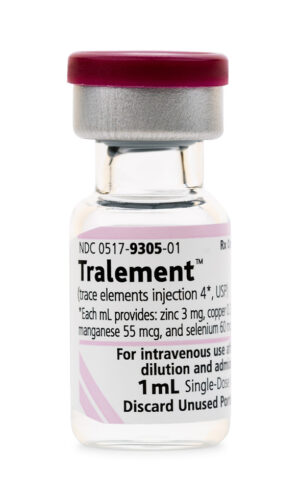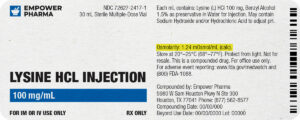


Magnesium, a divalent cation as well as the second most common intracellular cation in the body after potassium, plays a fundamental role in a significant number of enzymatic reactions pertaining to nucleic acid synthesis and energy metabolism.W.J.Fawcett, E.J.Haxby and D.A.Male, “Magnesium: physiology and pharmacology”, British Journal of Anaesthesia, vol.83, no.2, pp.302 – 320, 1999 Additionally, magnesium is important for glycolysis, oxidative phosphorylation, osteogenesis and bone ossification, and RNA as well as DNA synthesis. Magnesium also is integral in the regulation of the enzyme Na+/K+ ATPase which controls the intracellular as extracellular flow of sodium and potassium in living cells.L.Grycova, P.Sklenovsky, Z.Lansky, M.Janovska, M.Otyepka, E.Amler, J.Teisinger, and M.Kubala, “ATP and magnesium drive conformational changes of the Na+/K+ -ATPase cytoplasmic headpiece”, Biochimica et Biophysica Acta (BBA) – Biomembranes, vol. 1788, issue 5, pp. 1081 -1091, May 2009 “Magnesium: Fact Sheet for Health Professionals”, National Institutes of Health.[Online]. Generally, magnesium is typically found in food sources such as cereals and legumes, and is excreted renally from the body.W.J.Fawcett, E.J.Haxby and D.A.Male, “Magnesium: physiology and pharmacology”, British Journal of Anaesthesia, vol.83, no.2
Clinically, magnesium is administered in the body as magnesium salts. Magnesium chloride is one of the most common magnesium salts that is used clinically. Highly water-soluble, it comprises a magnesium halide bound to two inorganic chloride ions. “Magnesium chloride”, National Center for Biotechnology Information (2020). [Online]. Administered parenterally, some clinical indications for the use of magnesium chloride include peritoneal dialysis, total parenteral nutrition (TPN), fluid and electrolyte replacement, and the management of cardiovascular diseases such as congestive heart failure, supraventricular tachycardia, ventricular arrhythmia, and atherosclerosis.“DiNicolantonio JJ, Liu J, and O’Keefe JH, “’Magnesium for the prevention and treatment of cardiovascular disease” Open Heart vol. 5, issue 2, 2018.[Online]. M.Liu, E.Jeong, H.Liu, A.Xie, E.Young So, G.Shi, G.E.Jeong, A.Zhou, and S.C.Dudley Jr., “Magnesium supplementation improves diabetic mitochondrial and cardiac diastolic function”, JCI insight. [Online]. “Magnesium Chloride”, Drug Bank. [Online]. Magnesium chloride is expressed in breast milk in lactating mothers and is classified by the Food and Drug Administration as a pregnancy category C drug; it should only be administered in pregnant mothers when the benefits of administration outweigh the risks. “Magnesium Chloride (Rx)”, Medscape. [Online].
Care must be taken to avoid magnesium toxicity when administering magnesium parenterally. Signs of magnesium toxicity begin to manifest when serum levels exceed 5 mEq/L. Some signs that may be present which are indicative of magnesium toxicity are hypotension, nausea and vomiting, diarrhea, facial flushing, retention of urine, ileus, respiratory depression and paralysis, loss of deep tendon reflexes, muscle weakness, sinoatrial (SA) or atrioventricular (AV) node blocks , and cardiac arrest. The severity of the signs of magnesium toxicity is proportional to serum magnesium levels; the higher the levels of serum magnesium, the more severe the signs of toxicity. Immediate clinical intervention is necessary once features of magnesium toxicity are detected.“Magnesium: Fact Sheet for Health Professionals”, National Institutes of Health.[Online]. F.A. Ajib, J.M. Childres, “Magnesium Toxicity”. Treasure Island (FL): StatPearls Publishing; Jan. 2020. [Online].
Individuals with significant myocardial disease such as AV block should avoid receiving parenteral magnesium as much as possible as this could lead to a worsening of this condition. Very close monitoring is essential if parenteral magnesium has to be given in the face of an underlying myocardial condition.
Since the primary mode of magnesium excretion is through the kidneys, any form of renal impairment may result in elevated serum magnesium levels and concomitant magnesium toxicity. Renal functions should ideally be assessed before administration of parenteral magnesium. If there is any evidence of renal compromise as evidenced by a reduced creatinine clearance, serum magnesium levels should be closely monitored during parenteral magnesium administration. Parenteral magnesium should be avoided in individuals with a creatinine clearance of less than 20 mL/minute. M.J. Allen, S. Sharma, “Magnesium”, Treasure Island (FL). StatPearls Publishing, Jan.2020. [Online]. M.P. Guerrera, S.L. Volpe, J.J Mao, “Therapeutic Uses of Magnesium), American Family Physician, vol. 80, issue 2, pp. 157-162, July 2009. [Online].
Magnesium is known to block the release of acetylcholine in the neuromuscular system. Individuals with significant neuromuscular disorders such as myasthenia gravis should not be given parenteral magnesium as this may significantly worsen their condition. S.J. Bird, “Overview of the treatment of myasthenia gravis”, UpToDate. [Online].
In addition to the effect that magnesium could have on the various organ systems, parenteral magnesium may contain additional substances such as aluminum and benzyl alcohol which could be harmful to the body in high enough doses. High levels of aluminum in the body can lead to bone and neurological toxicity; this is especially evident in premature neonates and individuals with decreased renal function. In neonates, high levels of benzyl alcohol can result in gasping syndrome compromising metabolic acidosis, respiratory distress, hypotension, seizures, intracranial hemorrhage, and cardiovascular collapse.“Magnesium Chloride: Drug information”, UpToDate. [Online].
Parenteral magnesium chloride is an FDA pregnancy category C medication. It is expressed in the breast milk of lactating mother, with its concentration in breast milk roughly double maternal serum magnesium concentrations. Not enough clinical studies have been performed to demonstrate any malformative or fetotoxic effects from the administration of parenteral magnesium chloride to pregnant mothers. Therefore, parenteral magnesium chloride should only be administered to pregnant mothers when the benefits of its use outweigh any risks that may occur. However, some authorities state that parenteral magnesium chloride should not be administered 2 hours or less before delivery because of the risk of respiratory depression secondary to elevated magnesium levels in the neonate.
Magnesium easily crosses the placenta, passing from mother from fetus; maternal serum magnesium levels generally match levels within the fetus. Even though no controlled studies have been done, there have been reported instances of bony abnormalities and congenital rickets in some neonates after 4 to 13 weeks of parenteral administration to pregnant mothers. It is estimated that the risk of major birth defects is somewhere between 2 to 4% and the risk of miscarriages is 15 to 20%. “Magnesium chloride Pregnancy and Breastfeeding Warnings”. [Online].
Generally, care must be exercised when administering magnesium concurrently with other medications. Some medications can impair the Na+/Mg2+ transporter within the body which has an impact on intracellular and extracellular magnesium levels. Studies have shown that insulin inhibits the Na+/Mg2+ transporter and increases the intracellular concentration of magnesium; This is the likely reason why diabetics have a high prevalence of hypomagnesemia. Other causes of drug-induced hypomagnesemia are antimicrobials, beta adrenergic agonists, bisphosphonates, cardiac glycosides, proton-pump inhibitors, and some immunosuppressants. U. Grober, “Magnesium and Drugs”, International Journal of Molecular Sciences, vol. 20, issue 9, May 2019. [Online]. Additionally, medications such as calcitonin, glucagon, doxercalciferol, and potassium-sparing diuretics can result in increased serum levels of magnesium. M.P. Guerrera, S.L. Volpe, J.J Mao, “Therapeutic Uses of Magnesium), American Family Physician, vol. 80, issue 2, pp. 157-162, July 2009. [Online].
Parenteral magnesium can also impact the effectiveness as well as toxicity of other medications. Magnesium can enhance the vasoactive effects of calcium-channel blockers, which may lead to a worsening hypotension. For individuals taking antiplatelets or anticoagulants, concurrent administration of magnesium may result in increased bruising and bleeding as a result of decreased blood clotting. The risk of side effects and toxic effects is increased in individuals taking magnesium and muscle relaxants at the same time. “Magnesium”. RxLIst. [Online].
Parenteral magnesium administration is generally well tolerated, with minimal side effects. Adverse reactions, when they occur, are usually as a result of magnesium toxicity, the causes and symptoms of which have been previously discussed. Another cause of adverse reactions is toxicity to additional components of magnesium chloride such as aluminum or benzyl alcohol. Adverse reactions may also occur in the event of significant drug interactions. Close monitoring of the individual is generally recommended when magnesium chloride is administered parenterally.
Store this medication at 68°F to 77°F (20°C to 25°C) and away from heat, moisture and light. Keep all medicine out of the reach of children. Throw away any unused medicine after the beyond-use date. Do not flush unused medications or pour down a sink or drain.





